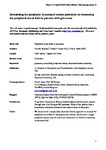Reclaiming the periphery: Automated kinetic perimetry for measuring peripheral visual fields in patients with glaucoma

Date
2017-02-01Author
Subject
Metadata
Show full item recordAbstract
PURPOSE: Peripheral vision is important for mobility, balance, and guidance of attention, but standard perimetry examines only <20% of the entire visual field. We report on the relation between central and peripheral visual field damage, and on retest variability, with a simple approach for automated kinetic perimetry (AKP) of the peripheral field. METHODS: Thirty patients with glaucoma (median age 68, range 59-83 years; median Mean Deviation -8.0, range -16.3-0.1 dB) performed AKP and static automated perimetry (SAP) (German Adaptive Threshold Estimation strategy, 24-2 test). Automated kinetic perimetry consisted of a fully automated measurement of a single isopter (III.1.e). Central and peripheral visual fields were measured twice on the same day. RESULTS: Peripheral and central visual fields were only moderately related (Spearman's ρ, 0.51). Approximately 90% of test-retest differences in mean isopter radius were < ±4 deg. Relative to the range of measurements in this sample, the retest variability of AKP was similar to that of SAP. CONCLUSIONS: Patients with similar central visual field loss can have strikingly different peripheral visual fields, and therefore measuring the peripheral visual field may add clinically valuable information.
Collections
Publisher
Place of Publication
Journal
Volume
Issue
Pagination
Author URL
Recommended, similar items
The following license files are associated with this item:

